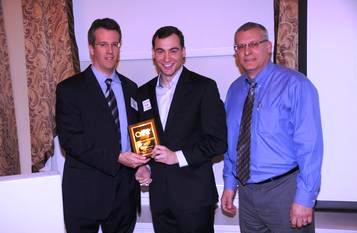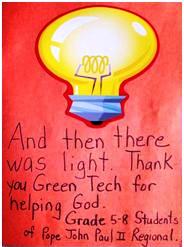Industry and Company News
Lighting Design for Schools
Posted February 27th, 2013 by GreenTech Energy Services
According to Designing for the Future, a guide published by the AIA Center for Building Performance, high quality lighting improves students’ moods, behavior and concentration, which in turn improves their learning. Lighting quality means visual comfort, good color, uniformity and balanced brightness. Poor quality lighting means shadows, glare, lamp flicker or chaotic lighting patterns. Here are some key strategies for achieving good quality lighting in schools:
- Control glare by using adjustable blinds or shades and shielding the lamps with lenses.
- Position fixtures in such a way that light is evenly distributed throughout the room.
- Keep lights clean and replace them when they start to flicker and buzz
- Include windows or skylights in every classroom if possible – studies show that students with daylight in the classrooms perform better.
- Make sure light levels are appropriate to the tasks being performed. The IESNA Lighting Handbook, 9th Edition, recommends footcandles of 40-50 in classrooms, 20-40 in computer rooms and 10 vertical footcandles in corridors.
- The brightest surfaces in the room should be the desktops and focal points such as the front wall or board.
- In the classroom, use pendant light fixtures that direct at least 50% of the light upward. In the corridors, surface-mounted fixtures allow for greater ceiling height.
- Use lighter-colored surfaces on walls and furniture, which save energy by maximizing reflected light, and are more comfortable visually.
- Use lighting controls to save energy
- Dimming controls adjust lights to appropriate levels for tasks being performed
- Photosensors optimize use of daylight
- Occupancy sensors make sure lights are not on when rooms are empty. Make sure sensors are located inside classrooms so they don’t detect motion in the corridor.
Morgan Properties Goes Green, Wins Energy Award
Posted February 25th, 2013 by dcoffin
Every year, the Greater Philadelphia Association of Energy Engineers presents awards to recognize the important work being done in energy by individuals, organizations and corporations. Winners are recognized at the association’s January 2013 meeting. This year, Drew Gravina (above center), Senior Facilities Analyst for Morgan Properties, was a recipient of this award. Drew was nominated by GreenTech Energy Services, the company he selected to install lighting retrofits in over 6,000 of Morgan Properties’ apartments in one year. Many of these projects cut energy costs and consumption by almost 50%.
And then there was light!
Posted October 26th, 2012 by GreenTech Energy Services
In July 2012, the New Jersey Clean Energy Program provided incentives to the state’s private and public K-12 schools for replacing T-12 fluorescent lights with new T-8 energy-efficient lighting. The incentives covered up to the entire cost of the upgrades, including materials, labor, permitting and disposal of the T-12 fixtures. A total of $6 million was allocated for this initiative, available to participants on a first-come, first-served basis. GreenTech Energy Services filed applications on behalf of many schools throughout the state. Among those that were accepted into the program were 16 schools from the Trenton Catholic Diocese.
At St. Catherine’s in Spring Lake, the difference between the old and new lights was “literally like night and day,” according to Rich Myer, the Parish’s Manager of Buildings and Grounds. “The old fixtures were unsightly, with cracked and yellowing lenses,” he says. “The new ones make everything look brighter. As one of the children put it, ‘I can see now!’ This is an upgrade that we’ve wanted to do for a long time, so the funding from the state was a real gift.”
The school’s principal, Sister Margo Kavanaugh, saw a similar reaction among the parents and teachers. “The first time people walked into the school after the project was completed, they asked what was going on here, because the whole place looked so much brighter and cleaner,” she says. “Our teachers go out of their way to create cheerful environments in their classrooms, and the new lighting has really enhanced their efforts.”
According to Donna Davidson, Associate Director of the Diocese’s Department of Catholic Schools, the project was also well received at Pope John Paul II in Willingboro. “The Principal was thrilled with the difference the new lighting was making,” she says, “and they loved the installation guys!!!” In fact, the students sent the installers on their way with handmade thank-you cards and a bagful of snacks. GreenTech is proudly displaying the card in its corporate offices and the installers are enjoying their Cheetos.
Whiter Brighter Wash (Alley)
Posted October 25th, 2012 by GreenTech Energy Services
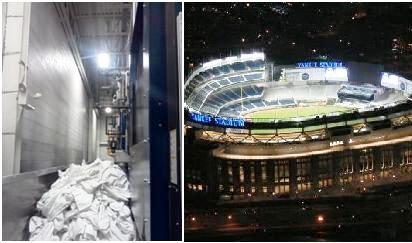 The Cintas plant in Union, NJ recently hired GreenTech Energy Services to perform a lighting upgrade, with the goals of reducing energy consumption and improving safety. In production areas, boiler room, tank room, and maintenance areas, existing 400-watt metal halide high bay fixtures were replaced with T8 fixtures with reflectors. As the project progressed, the company also decided to install additional lighting behind the washers and dryers to increase visibility and safety in the wash alley.
The Cintas plant in Union, NJ recently hired GreenTech Energy Services to perform a lighting upgrade, with the goals of reducing energy consumption and improving safety. In production areas, boiler room, tank room, and maintenance areas, existing 400-watt metal halide high bay fixtures were replaced with T8 fixtures with reflectors. As the project progressed, the company also decided to install additional lighting behind the washers and dryers to increase visibility and safety in the wash alley.
The impact was tremendous, reports Cintas field engineer Doug Cosmini. The KW electrical demand dropped by even more than the original estimates, so the savings will be greater than anticipated. And the level and quality of light has been significantly enhanced. “Before, you needed a flashlight to look at the washers and dryers,” says Cosmini. “Now the partners think that the wash alley is brighter than Yankee Stadium.”
Posted October 24th, 2012 by GreenTech Energy Services
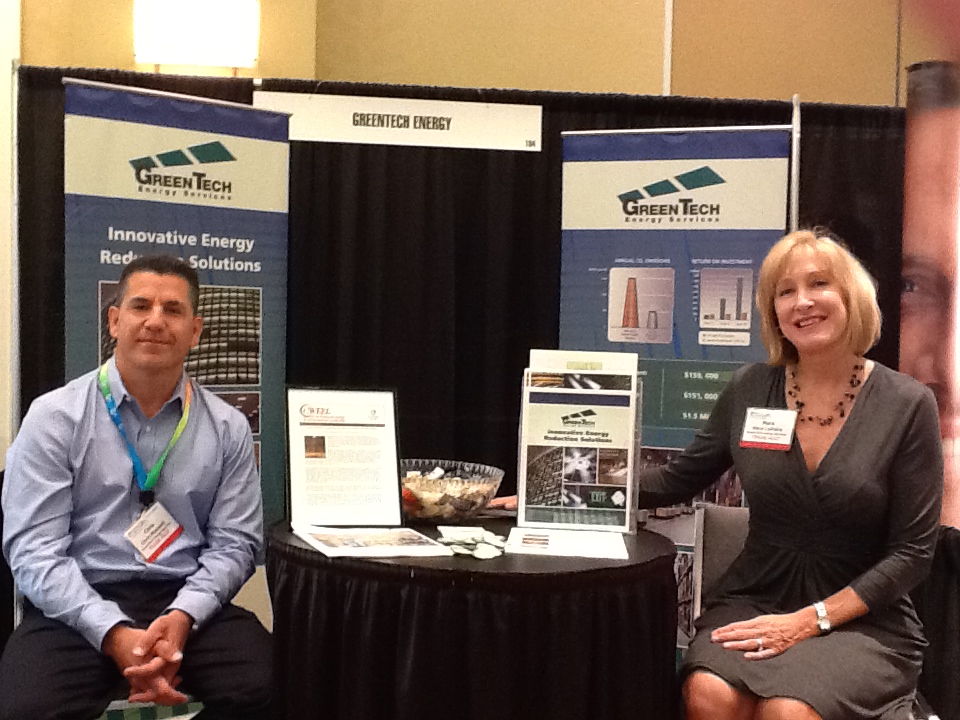
Mara LaVoice and Chris Maxwell staffing the GreenTech booth at Edison Electric Institute’s National Key Accounts Workshop in Baltimore, MD this week.
SPOTLIGHT ON MORRISVILLE SCHOOL DISTRICT
Posted October 22nd, 2012 by GreenTech Energy Services
GreenTech Energy Services was hired to upgrade the lighting in the Morrisville School District. In classrooms, offices, and other interior rooms, obsolete T12 fluorescent lamps were replaced by new T8s, incandescent lamps were replaced by compact fluorescents, and occupancy sensors were installed to assure lights are turned off when areas are unoccupied. In the high school gym, metal halide high bays were replaced by T5 fluorescents with reflectors and lens cages. LED strips were installed in hallway ceilings and all incandescent exit signs were replaced by LED. Outside, metal halide wall packs were replaced by induction wall packs, and mercury vapor cobra heads on parking lot poles were replaced by induction cobra heads. The project will save the district over $77,000 a year.
“The input from Greentech during the survey and design stage was crucial in terms of showing the board what was needed, and it also allowed the facilities manager to adjust the scope in a way that made sense,” says Paul DeAngelo, Morrisville Business Administrator. “Thanks to the survey, we found lights that we didn’t even know we had. We discovered an exterior light that hadn’t been turned on for years that we’d been paying for. We got some of that money back from the utility retroactively and then terminated the light.” During the installation stage, GreenTech did three rooms in a hallway at a time. When teachers came in the morning, they could easily compare the finished and unfinished rooms. “The difference was shocking – like night and day,” says Mr. DeAngelo. He adds that the GreenTech crew worked cleanly and quietly, and everything went according to schedule. The end result, he says, has pleased everyone from faculty and administration to the community at large. “Now when people come into the building at night for meetings they can find their way down the hallways. The custodians can see the floors well enough to mop, and when I come in at 6 am, I don’t have to fish around for my office keys in the dark,” says Mr. DeAngelo. “The LED strips shed just enough light without eating up a lot of energy.”
Photos of cafeteria, gym and classrooms before and after the lighting retrofit:
Advanced Energy Retrofit Opportunity Fund of the Energy Efficient Buildings HUB
Posted October 16th, 2012 by GreenTech Energy Services
 The Energy Efficient Buildings Hub (EEB Hub) in Philadelphia has launched a program to award funding for renovation projects that incorporate an “advanced energy retrofit.” Companies with plans to undertake such projects are invited to apply if they meet the following criteria: renovation projects must be located in Delaware, Philadelphia, Montgomery, Bucks and Chester County PA; or Mercer, Camden, Gloucester, Burlington or Salem County NJ. Ideally, projects should be in buildings that are smaller than 250,000 sq. ft., which is representative of the majority of commercial buildings in the Philadelphia region. Eligible applicants include building owners, facility managers, tenants, service providers, architects, and energy and design firms. If a project is selected for an award, funding will be provided for certain services but not directly to the building owners. The benefits to them will include improved operating cash flow, higher asset value, improved occupant comfort and indoor environmental quality, and reduced environmental impact of building operations. The full RFI can be found on the EEB Hub website at eebhub.org/rfps.
The Energy Efficient Buildings Hub (EEB Hub) in Philadelphia has launched a program to award funding for renovation projects that incorporate an “advanced energy retrofit.” Companies with plans to undertake such projects are invited to apply if they meet the following criteria: renovation projects must be located in Delaware, Philadelphia, Montgomery, Bucks and Chester County PA; or Mercer, Camden, Gloucester, Burlington or Salem County NJ. Ideally, projects should be in buildings that are smaller than 250,000 sq. ft., which is representative of the majority of commercial buildings in the Philadelphia region. Eligible applicants include building owners, facility managers, tenants, service providers, architects, and energy and design firms. If a project is selected for an award, funding will be provided for certain services but not directly to the building owners. The benefits to them will include improved operating cash flow, higher asset value, improved occupant comfort and indoor environmental quality, and reduced environmental impact of building operations. The full RFI can be found on the EEB Hub website at eebhub.org/rfps.
Look at Energy Savings Before you “Leep”
Posted October 11th, 2012 by GreenTech Energy Services
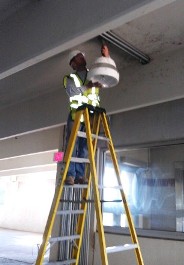 The Lighting Energy Efficiency in Parking (LEEP) Campaign was launched at the end of September to offer guidance and recognition to parking lot and parking facility owners interested in implementing lighting redesigns or retrofits that will cut their energy usage.
The Lighting Energy Efficiency in Parking (LEEP) Campaign was launched at the end of September to offer guidance and recognition to parking lot and parking facility owners interested in implementing lighting redesigns or retrofits that will cut their energy usage.
To become part of the campaign, parking facility owners submit their project information online at LEEPcampaign.org. The deadline for submitting reports is January 2014. Any project started after 2010 and completed before November 2013 is eligible. LEEP will award recognition to participants in various categories, announcing the winners in February 2014. Awards will be based on:
- highest savings at a single site: retrofit or new construction
- highest percentage savings at a single site: retrofit or new construction
- best use of controls
- largest number of sites upgraded
- largest portfolio-wide energy savings
- largest percentage of sites upgraded
If a company is selected for a possible award, the LEEP campaign needs to verify savings, either through existing metering onsite if available, or through spot measurements.
The LEEP Campaign goal is to to have 100 million square feet of parking space to use roughly 1/3 less energy compared to standard 90.1-2010. That, says the organization, will equal the annual electricity use of almost 4,500 homes or annual greenhouse gas emissions from almost 7,000 passenger vehicles. State-of-the-art lighting technologies can last up to five times longer than traditional outdoor lights. They quickly pay for themselves by cutting energy costs up to 70% and maintenance costs up to 90%.
Factoids about energy usage in N.J. from the Dept. of Energy
Posted October 10th, 2012 by GreenTech Energy Services
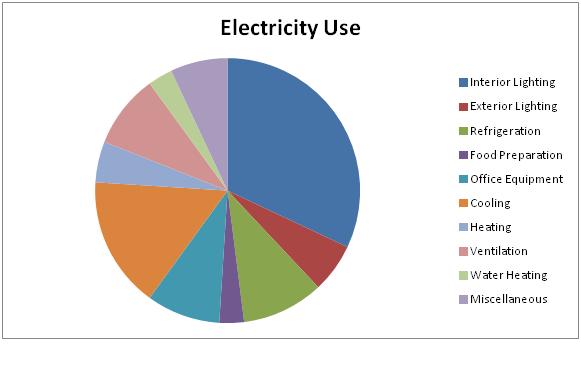 A Market Study of Energy Usage in New Jersey conducted by the U.S. Department of Energy turned up a few interesting facts:
A Market Study of Energy Usage in New Jersey conducted by the U.S. Department of Energy turned up a few interesting facts:
Commercial buildings account for 51% of all electric usage in the state, followed by residences (38% ) and then industrial facilities (only 11%).
Among all commercial facilities, retail stores account for almost 20% of all electricity use, followed by offices, grocery stores, healthcare facilities, and warehouses. Among the smallest users are schools, restaurants and hotels.
The majority of electricity use in commercial establishments goes toward lighting, followed by cooling, refrigeration, ventilation and office equipment.
Over the next four years, the greatest opportunity for commercial electricity savings is interior lighting efficiency upgrades, following by exterior lighting, refrigeration and cooling.
The industries that use the most electricity are chemical and pharmaceutical, followed by paper products and food products.
Motors use the greatest amount of electricity in industrial buildings, followed by process (the chemical or mechanical steps needed to manufacture an item), and then interior lighting.
Motor drives and controls offer the greatest potential for saving electricity in industrial buildings, followed by controls on pumps, fans and compressed air, and then by efficient high bay lighting.
Energy Efficiency Programs: Lessons Learned
Posted October 2nd, 2012 by GreenTech Energy Services
In 2008, Pennsylvania passed a law designed to cut energy consumption in the state by requiring electric utilities to reduce their overall electricity load. They have done so by incentivizing customers to implement energy efficiency measures or participate in demand-response programs. Most of the utilities are successfully meeting their energy-reduction goals. The state is in the process of designing Phase 2 of the program and has solicited input from the utilities and other sectors of the energy industry. Here are some of the suggestions offered and lessons learned, which could be useful in other states where programs are being launched or refined.
- Advanced metering – under the current system, utility bills are averaged out so customers can’t see how much energy they are using at any given time and what it’s costing them. Usage data need to be “bi-directional,” going to both customer and utility.
- There needs to be a more competitive retail market. When customers are given the option of choosing their electric suppliers, most continue to rely on their electric distribution company (the utility itself) instead of seeking the most competitive rates.
- Financing is needed to help customers undertake capital-intense projects. On-bill financing is one option. (The utility acts as collector: as the customer’s energy consumption drops due to the energy conservation measures they implement, the utility uses the savings to pay for the project, passing the money on to the lender.)
- Energy efficiency has to be presented as a least-cost resource and low-risk/high-return investment, not just an environmental benefit. The cost of delivering any type of energy, renewable or otherwise, is always higher than just reducing the need for it.
- Utilities need to allow adequate lead time before making changes to their incentive programs. Projects undertaken by large commercial and industrial customers typically have very long lead times due to complicated approval processes and the burden of obtaining analytical evidence to support the projects. Building M & V (measurement and verification) procedures into the system will help.
- The complexity of the paperwork initially discouraged many smaller facilities from implementing projects. In response, the utilities created a “direct discount” program under which the rebate goes directly to the trade ally (contractor), who handles all the administrative work. The end-user winds up paying for only about 30% of the project.
Along with implementing energy efficient technology, much can be accomplished simply through behavioral change, such as shutting off lights in unoccupied areas. This is especially true in schools where energy efficiency can be incorporated into the curriculum. As one administrator put it, if you find one passionate teacher in the school who can transmit enthusiasm to the students, they will spread the word, engaging their parents and the community at large.
GreenTech Energy Services
email@greentechenergy.com
Phone: 856-439-9400
122 East Kings Highway, Ste 503
Maple Shade, NJ 08052

